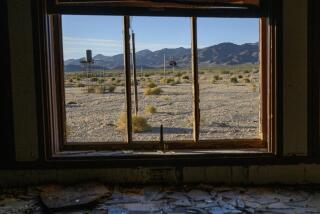Op-Ed: Earth’s dismal water future, mapped
Satellite data and images are provocative, even disturbing. They confront us with a global view that can be at once breathtaking, like a piece of art, and yet, in this era of rapidly changing climate, they paint a picture of the demise of the environment. How and if we will respond to what we see is uncertain. That uncertainty lies at the root of our perilous future.
Last month, my colleagues and I published a report the centerpiece of which is a global map, derived from satellite data, that shows how the distribution of Earth’s fresh water has rapidly changed since 2002. We analyzed measurements from NASA’s Gravity Recovery and Climate Experiment satellites to determine trends in total water storage — groundwater, soil moisture, surface waters, snow and ice — over nearly a decade and half.
Although the map is strikingly simple — color coded from blue to red to show average increases and decreases per year in available fresh water — the story it reveals is complex and troubling. Progressively deeper hues represent the greatest and most problematic rates of change. The deepest blues indicate areas where flooding has been increasing, the deepest reds indicate areas where water losses have been most severe.
There have always been geographically distinct classes of water “haves” and “have-nots.” Now, as the map shows, those regions of water security and insecurity are shifting radically.
Climate models predict that changing weather and temperature patterns will cause the world’s high-latitude and tropical regions — the areas that are already wet — to get wetter, while already dry, arid and semi-arid regions will get drier. But those models foresee major changes coming at the end of the 21st century. Our map clearly shows new patterns emerging today. This includes the U.S.: The northern half of the country has become much wetter, while the southern half has become much drier.
The map is speckled with nearly three dozen regional hot spots for water insecurity — where changes in the water supply will seriously threaten a region’s health, welfare and environment.
Declining groundwater quality and subsiding land are signals that the aquifers are being pushed past their tipping point.
Some are driven by climate change, like the melting of the Greenland and Antarctic ice sheets, and the mountain glaciers in Alaska, Colombia, Peru, Patagonia and the Himalayas. Others are the direct result of water management, or lack thereof. Many indicate areas where groundwater is being rapidly depleted, pumped at unsustainable levels to irrigate crops and raise livestock for a growing population or in response to drought.
The water future the map portends is daunting.
In California’s Central Valley, parts of which are dark red on our map, mid-latitude drying, persistent drought and falling water tables are already driving the cost of drilling deeper wells far beyond what any average family can afford. And declining groundwater quality and subsiding land are signals that the aquifers are being pushed past their tipping point, losing more water than can be replenished in a year.
The farmlands of the Central Valley and America’s Great Plains, another hotspot on our map, feed the United States and the world. If global groundwater depletion continues there, and in similar regions (northwestern India, the North China Plain, South America’s Guarani Aquifer), it will undoubtedly drive global food insecurity. Higher food prices, shifts in crop selection and changing food availability will be the logical outcome. Ultimately, difficult choices will have to be made, such as moving agriculture to where more water is available, or moving water to where the farms are.
Regions where groundwater and glaciers are disappearing threaten not only food availability, but also the health and livelihoods of the billions of residents living in these areas. Several of these hotspots span political boundaries and coincide with volatile regions where the lack of water may act as a trigger for violent conflict. The role of drought in the Syrian war and the refugee crisis is now well understood.
Whether coupled with conflict or not, water insecurity, as always, will continue to mobilize populations. Changing water availability has the potential to generate waves of millions of future climate refugees.
Governments and society are unprepared to cope with the tenuous water future that our research has literally mapped out. The rapid pace and global scope of change requires a response across regions and national boundaries. Few institutions and networks with that kind of authority and reach exist, but they must be fostered, and fast. We need a new water diplomacy that will treat this crucial resource as a vehicle for cooperation rather than conflict.
The map points to the pressing need for national-level water policy discussions in the United States. We must demand more accountability from elected officials, and from the food industry, the biggest user of water on the planet. Our leaders must know that, as voters and consumers, we expect their commitment to water security, in quantity and quality, before they can win our support.
The data we analyzed maps the here and now, and signals the future. How will we respond? .
Hydrologist Jay Famiglietti is a professor and incoming director of the Global Institute for Water Security at the University of Saskatchewan in Canada. He is senior author of the article “Emerging Trends in Global Freshwater Availability,” published in Nature in May.
Follow the Opinion section on Twitter @latimesopinionand Facebook
More to Read
A cure for the common opinion
Get thought-provoking perspectives with our weekly newsletter.
You may occasionally receive promotional content from the Los Angeles Times.










